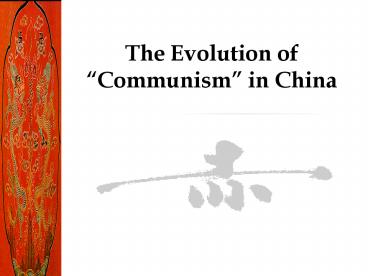The Evolution of Communism in China - PowerPoint PPT Presentation
1 / 13
Title:
The Evolution of Communism in China
Description:
Era of Collectivization (1955-58) Great Leap Forward (1958-60) ... incremental fashion; encouraging some capitalist activities; and overseeing a ... – PowerPoint PPT presentation
Number of Views:108
Avg rating:3.0/5.0
Title: The Evolution of Communism in China
1
The Evolution of Communism in China
2
Chronology of Chinese Communism
- New Democracy (1949-55)
- Era of Collectivization (1955-58)
- Great Leap Forward (1958-60)
- Great Proletarian Cultural Revolution (1966-76)
- Death of Mao Zedong (1976)
- Era of Deng Xiaoping (1978-97)
- Tiananmen Square Incident (1989)
- Era of Jiang Zemin (1997-2002)
- China Enters WTO (2002)
- Era of Hu Jintao (2002 - ? )
3
Dr. Sun Yat-sen
The Chinese revolutionary leader Sun Yat-sen had
a tremendous impact on the development of modern
China. Sun was the catalyst in the overthrow of
Manchu rule (1911). His Three Principles of the
PeopleNationalism, Democracy, and Peoples
Well-Beingbecame the countrys guiding
principles.
www.encarta.msn.com
4
Chiang Kai-shek (1887-1975)
Chiang Kai-shek worked with US forces to expel
the Japanese forces from China during the second
world war. He was deeply nationalistic and hated
communism. Thats why we liked him, even though
he and his government proved to be fairly
corrupt. He fought the Japanese imperialists
hard and won many battles against the communists
opposed to his rule. He would eventually lose to
Mao and the communists and flee to the Chinese
province of Taiwan with his remaining forces,
sure that he would return one day to the
mainland. He never did and the two governments
still remain miles apart in distance and ideology.
www.encarta.msn.com
5
Long March Orations
Communist forces under Mao Zedong battled out of
the encircling forces of the Kuomintang (KMT).
Chiang Kai-shek wanted to wipe them out, but
lacked the forces to do so. Mao and his followers
went on a 6,000 mile odyssey that led from
Jiangxi Province in southeastern China to Shaanxi
Province in the north. There they formed a new
base and eventually defeated the KMT. Chiang and
the KMT fled to Taiwan and formed the exiled
Chinese nationalist government. Today the
Republic of China (Taiwan) still claims to be the
rightful government of China. The Peoples
Republic of China (Communist China) dominates the
mainland. Time will tell which government will
lead the reunified China, and lots of people may
have to die to accomplish this feat.
www.encarta.msn.com
6
Maos Long March (1934-35)
www.encarta.msn.com
7
Mao Zedong(1893-1976)
- Maos Little Red Book a modest volume of quotes
to encourage good behavior and revolutionary zeal - Red Guard enforces new code
- Old code, referred to as the four olds, are old
thought, old culture, old customs, and old
habits are dismissed during the Cultural
Revolution
www.encarta.msn.com
8
Deng Modernizes China
Countering Mao's legacy of idealism with
pragmatic policies liberalizing the Chinese
economy and society in incremental fashion
encouraging some capitalist activities and
overseeing a period of rapid economic growth.
Deng was responsible for incredible economic
expansion, from 1978 to 1997. He opened
diplomatic relations with the US and Japan,
leading to international investment in China. His
four-pronged foci were
- Industry
- Agriculture
- Technology
- National Defense
www.encarta.msn.com
9
Communism Meets Capitalism at Tiananmen Square,
China
Photograph by Keith M. Bell
10
Deng Xiaopings Legacy
- Deng was able to set his country on the path to
economic development, but that was only in the
coastal zones. The interior of the country has a
populace that remains largely isolated and poor,
without the basic amenities and poor education.
The coasts are buoyed by newly acquired Hong Kong
(1997) from the British and Macau (1999) from the
Portuguese. These economic hubs are in close
proximity to new Special Economic Zones (SEZs) on
the coast. Another new development is taking
place at Pudong, next to the well-established
city of Shanghai. These production zones will
propel the Chinese economy for the next century. - China is rapidly becoming a country of haves and
have nots. This was not supposed to be the
communist way. But Deng saw that this wouldnt
work anyway, something Mao never figured out. He
split politics and economics, believing they were
mutually exclusive. This was a totally new path
for communist dictators to take in the world and
proved once and for all that the ideology of Karl
Marx and Friedrich Engels was incompatible with
human tendency. So, no matter whether it was
Marxist teachings, Leninist ideologies, or Maoist
leanings, none of these philosophies could work
in the real world.
11
Graph generated by Keith M. Bell - Stats derived
from WorldAtlas.com
12
Jiang Zemin (1997-2002)
www.encarta.msn.com
- On the previous slide you saw a comparison of
economies around the world. The USA is still on
top, but one should understand that the Chinese
are coming on strong. - Dengs decisions in the late 1970s still impact
the country. - China was led by Jiang Zemin in the late 90s and
early 2000s. He was pivotal in gaining Chinas
entry into the World Trade Organization,
something that will only grow the economy of
China even more. Jiang recently appointed a new
leader of China Hu Jintao (2002).
13
End of Dengs China
- PowerPoint
- authored by
- Keith M. Bell































